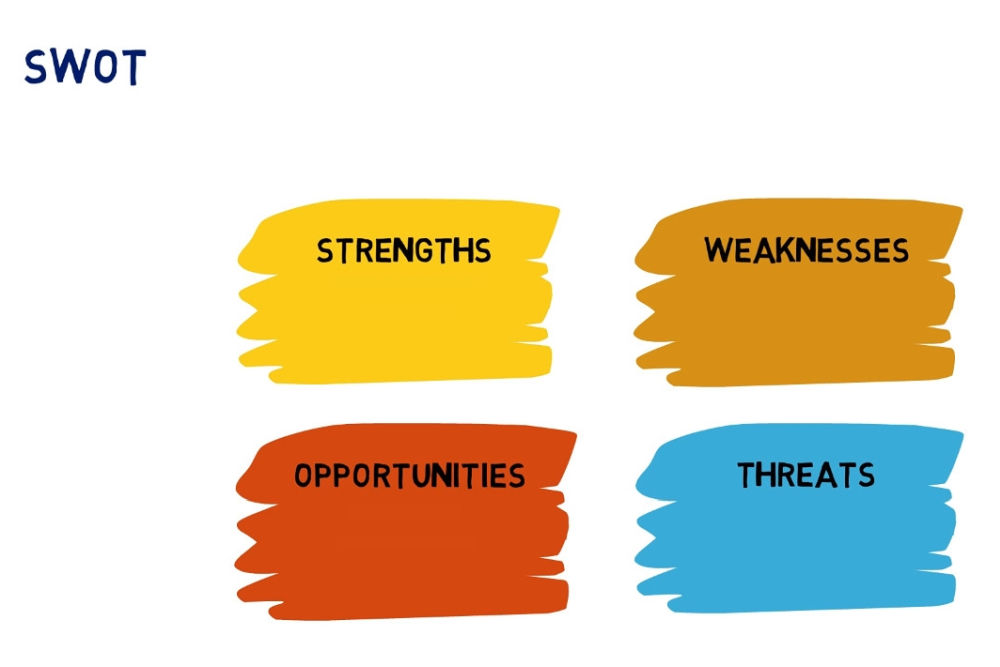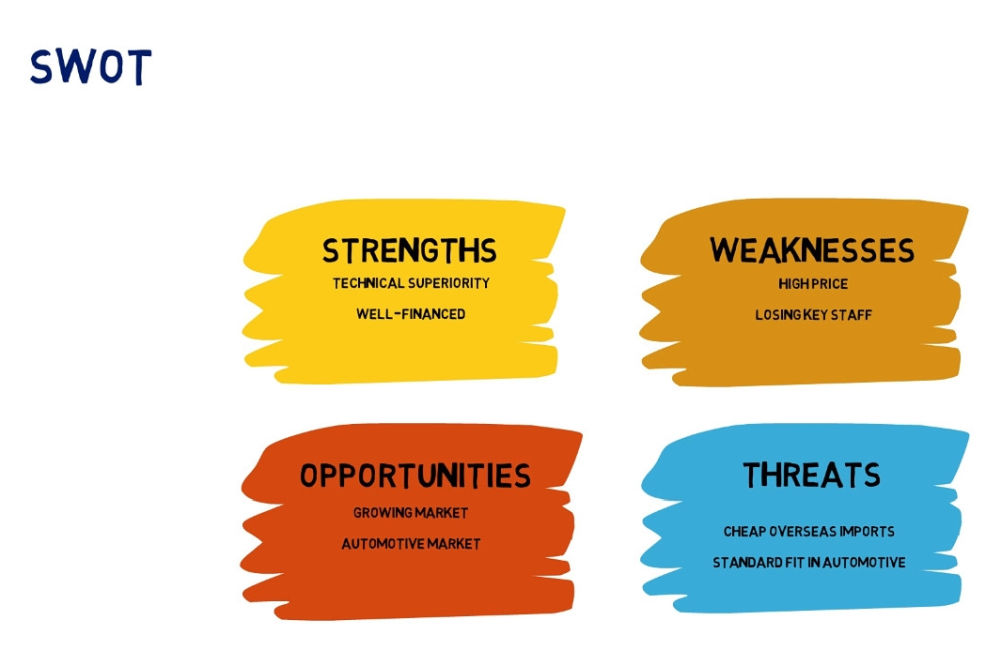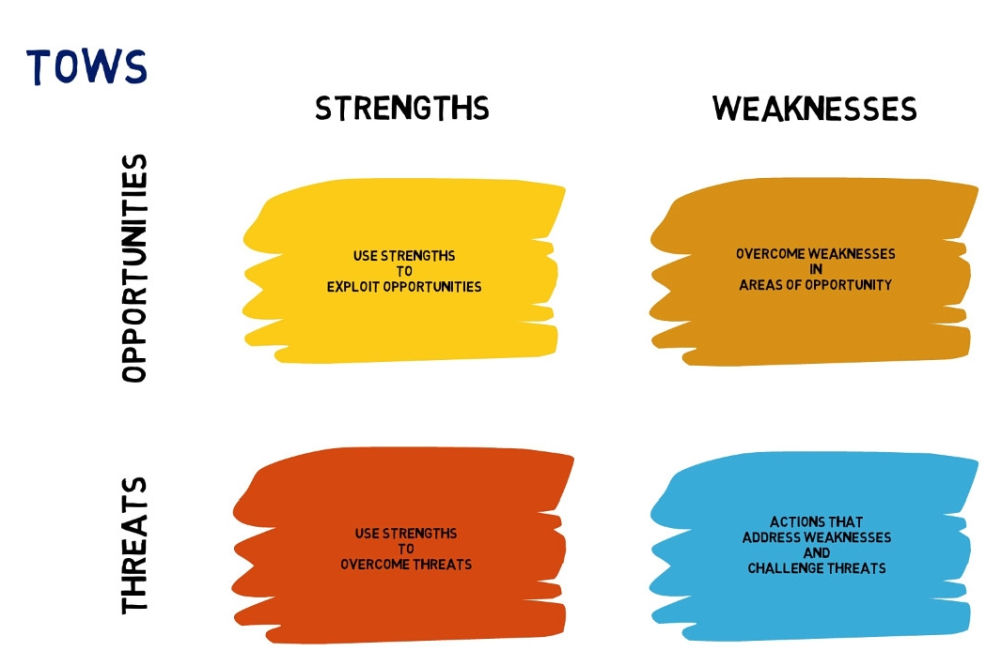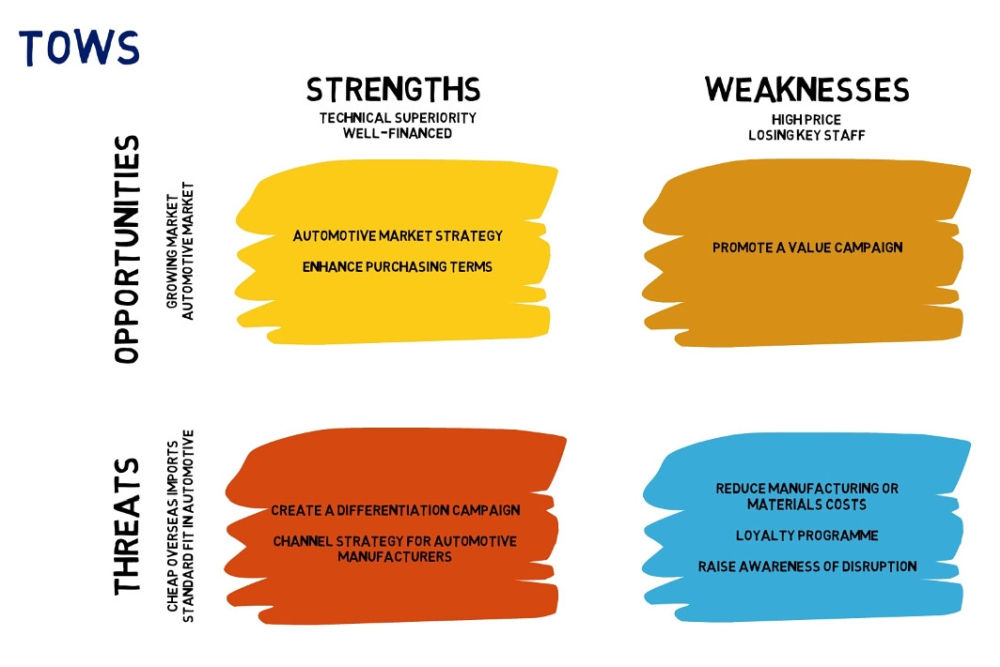TOWS Model Analysis (demo)
This is a hidden version of the page on the TOWS model. It’s only here for the marketing automation demo. The ‘live’ page can be found here.
The TOWS analysis model adds actions to a traditional SWOT analysis, making it a powerful summary of the future rather than a limited assessment of the present.
- SWOT analysis and its limitations.
- SWOT analysis in action.
- Going beyond SWOT with TOWS.
- TOWS analysis in action.
Let’s compare the models.
SWOT analysis and its limitations
SWOT analysis has been with us for decades. It’s been helping companies identify their internal Strengths and Weaknesses and the external Opportunities and Threats they face. It’s a simple model to understand but, despite that, most of us inwardly cringe every time somebody suggests using it.
Here’s why.
SWOT analysis doesn’t say anything about future actions. Wouldn’t it be better if we just expanded the model a little to say how we’re going to capitalise on our Strengths, compensate for our Weaknesses, exploit the Opportunities and challenge the Threats?
That’s exactly what TOWS analysis does. It keeps the simplicity of SWOT but adds actions. It becomes infinitely more useful by doing so. Every SWOT analysis ever produced evokes the question “What next”? TOWS incorporates the answer.
SWOT analysis in action
Imagine you’re a company producing engine analysis parts. A traditional SWOT analysis would adopt the usual four box structure you can see illustrated above.
- Our Strengths could be technical superiority and the fact that the company is well financed.
- Our Weaknesses could be that we are more expensive than our competitors and we’re losing key staff to start-ups.
- Our Opportunities could be that our existing markets are growing and we have the potential to move into a new market for automotive engines.
- Our Threats might be cheap imports from overseas and the possibility that automotive manufacturers will fit our kind of components as standard, killing the chance of after-market upgrades.
By SWOT standards, that’s quite a useful analysis. By commercial standards, it’s totally useless. Any Managing Director receiving that from one of their managers would have no idea what they intended to do about it. They’d probably have to read a long report when what they really wanted was something as neat and succinct as a SWOT report – but more informative.
That’s where TOWS comes in.
Going beyond SWOT with the TOWS Model
The TOWS Model makes the four parts of a SWOT analysis the axis headings for a new chart. This creates four boxes into which you can put actions.
- At the intersection of Strengths and Opportunities, you describe how you’ll use your strengths to exploit the available opportunities.
- At the intersection of Weaknesses and Opportunities, you describe how you’ll challenge or overcome your weaknesses in the areas of opportunity.
- At the intersection of Strengths and Threats, you’ll describe how you use your strengths to overcome any threats you face.
- At the intersection of Weaknesses and Threats, you’ll describe any measures you can take that might address a weakness and the threat at the same time. It’s harder to promote actions in this quadrant than any of the others because you have so little ammunition. The temptation is to draw on some of your strengths or opportunities but that defeats the purpose of the model.
The TOWS Model in action
Let’s look at how that might work in action using the results from our SWOT analysis.
- Our component manufacturer would want to develop a strategy to target the automotive market. That strategy would have to revolve around a company strength such as technical superiority. The fact that the company is also well financed could be used to offer purchasing terms that start-up competitors couldn’t match. This could be longer credit terms, smaller deposits at the time of order or a hire purchase program that spreads the cost over several years. These financial inducements cost money that a cash-strapped start-up probably can’t afford.
- A high price might be seen as a weakness. However, in our company’s existing growing market and its potential new automotive market, this could be addressed by promoting a value campaign. It’s not a new idea and it’s always hard to persuade people to buy anything but the cheapest product, but such campaigns do work. The value campaign could also stop key staff leaving. It might make them feel proud to be with the market leader, to be part of the winning team.
- Strengths are an obvious tool to be used against threats. In our company’s example, a differentiation campaign that promotes our technical superiority is a great way to challenge the flood of cheap imports from overseas. If the company is worried about automotive manufacturers making this type of technology a standard part of future vehicles, it’s probably a good time to develop a channel strategy so those manufacturers become our customers instead of somebody else’s.
- Defining actions that address a weakness and a threat is much harder. How would our company address the weakness of a high price with the (related) threat of cheap imports? If we want to avoid drawing on strengths that belong in another quadrant of the model, we could suggest new manufacturing techniques or materials that will reduce costs. Or a loyalty program that rewards customers for the historical purchases they’ve already made. That’d be attractive too. Alternatively, if our company felt the need to go negative, it could start a campaign about the disruption customers would suffer when switching from one supplier to another.
The purpose of this article isn’t to propose actual solutions to a hypothetical situation like this. It’s to explain the TOWS Model. If you compare the completed SWOT analysis with the completed TOWS Model analysis, it should be clear how much more informative the TOWS report is. In one simple chart it summarises a business’ current situation, outlines its future plans and illustrates the connection between the two.




